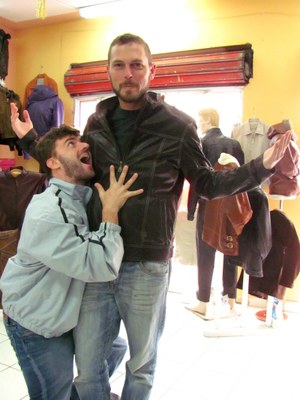From the Amazon to the Pacific (Part II)
Journal 15: Biking from Chachapoyas, to Kuelap, Leymabamba, Cajamarca, and Trujillo
The Heart of the Chacha Empire
We left Chachapoyas on the same road we arrived on, but this time, it left us with a nice 800m decent to start the day. Then we said goodbye to concrete and turned off in the direction of Tingo. The road flattened out, and we enjoyed a pleasant ride that morning alongside beautiful orchards. Around 1, we arrived at Tingo, which would be our launching point for Kuelap, which looked to be in walking distance on our map.
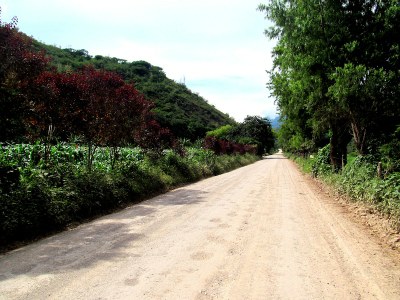
Tingo was located about 250m above the river valley in which we were traveling, but the road leading up to it was as steep as any we´d seen, and we resorted to pushing our bikes most of the way, nervous that this might become a norm on the long unpaved stretch ahead. A young boy followed us the entire way, begging us for money. My dad is working in Kuelap, and I don´t have money for lunch he said. Can I eat with you guys. All we have is this mango, Bibi responded. 3 minutes later he told us his father had died yesterday and he was all alone. It wasn´t the first time I´d seen a kid kill off a family member in a story in hopes of deriving sympathy. We would have none of it.
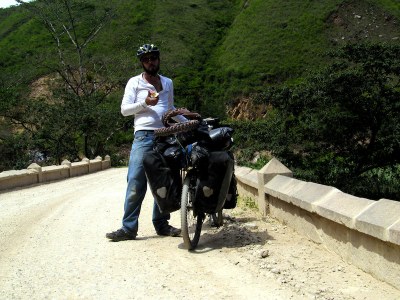
Bibi fell in love immediately with the plaza in this little town, which had a cute mushroom shaped gazebo in the center and figures of animals cut into the shrubs. We stopped for lunch, and met Timo, or some such name from Findland. He was sitting on the side of the road, waiting for a car to take him up to Kuelap. He looked to have been there for some time, and we invited him to have lunch with us. He told us stories taking ayahuasca in the jungle with a shaman for six weeks. I wasn´t surprised. He had that twisted energy of somebody that had been tripping long and hard. We made plans to go up to Kuelap together and after lunch we asked around. Someone offered to take us for 120 soles – ($50) there and back which we turned down. It seemed steep, but it turned out the trip was a lot farther than we thought. I took a killer nap with Bibi. She woke up before me to see what was going on in town. It seemed there was a brass band outside, but I had an engagement with the sandman that I wanted to keep.

I awoke around 5pm, and walked outside just in time to see the hoisting of the Carnival tree. There was indeed a hired band, with dancing, painted faces, and lots of drinking. I chatted with an older couple while she fired away on the camera.
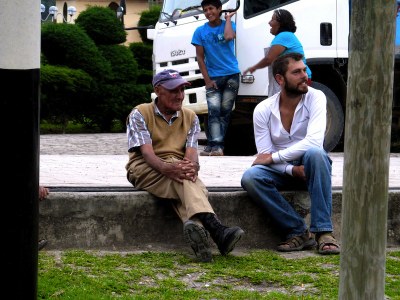
The party later moved over to a house called mayor domo. This family had been elected to provide food for the village party. After having liquor thrown on her head from behind, Bibi was dragged up to dance, and I took shots with the men off to the side.
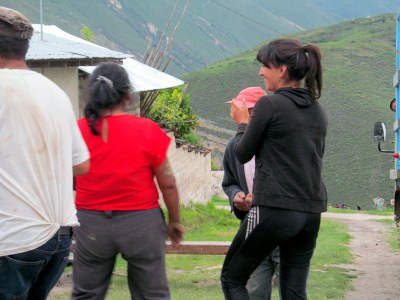
A short while later, we were invited inside the home and given what I think was a potato based meal, which, if nothing else, was filling. We learned about the traditions we were seeing and shared our story before bidding farewell.
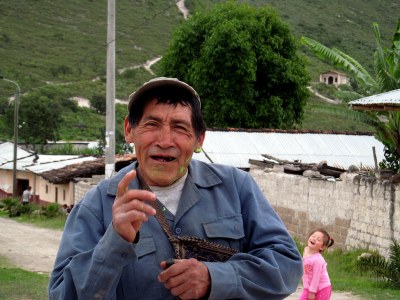
The next morning before sun up, a bus was supposed to arrive to take us up the mountain to Kuelap, a set of ruins larger and older than Machu Picchu, if not quite as picturesque. Either we missed it by a matter of minutes, or it never arrived. I immediately advocated for walking. There wasn´t another road, so if anyone passed we could hitch a ride with them. We´d heard it was 2.5 hours.
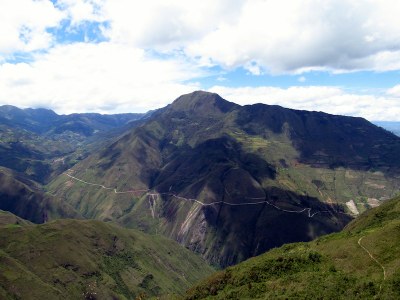
We watched a gorgeous sunrise. After an hour or so, a truck came by and we flagged it down. “Is this the road to Kuelap?” This was our lead in question. What we really wanted was a ride. “Yes.” “Is it far?” “35km.” Way to far to walk. We jumped in the back of his truck, and he took us to a village, about 14 kms up the road. He pointed out the road to Kuelap, along with the sign stating we were still 19kms away. It was as the old woman had said the previous night. Esta Leeejos!!!
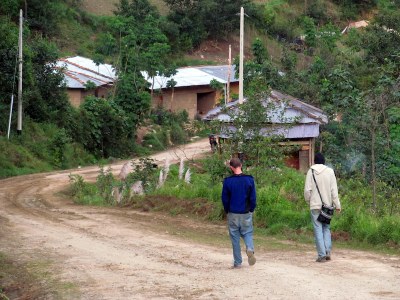
We began looking for a ride, but there were no cars in town, and we were advised that no one would be going up that way. We stopped in for breakfast, where we were finally told that yes, tour vans from Chachapoyas would be passing through around 10, and we might catch a ride with one of them. Fantastic. I took a nap on the side of a river while Bibi flashed photos and chatted with the locals. Timo sat nearby staring distantly out at the valley for what seemed like hours. At last, the van arrived, and we hopped aboard.
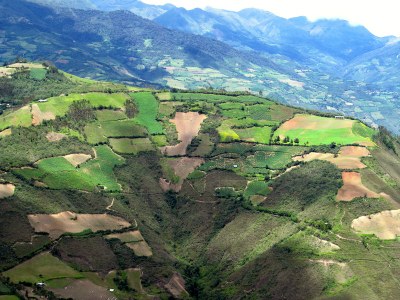
Kuelap is a walled fortress on a mountain top that was never conquered. It was the center of the Chacha empire, and when the Incas arrived, they took the city by siege, surrounding it and eventually forcing a surrender. They ultimately assimilated the Chacha society into their own. The one entrance is a narrow slit in the wall. With armed guards above, invaders would be welcomed with a barrage of rocks and boulders from the watch posts above.
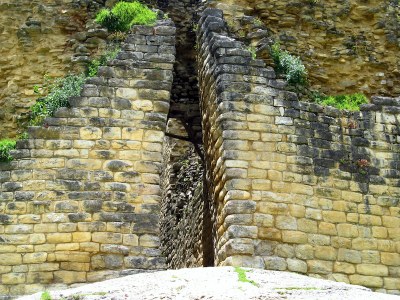
What remains today are the circular bases of what were once stone houses. The views that Kuelap afforded its Chacha leaders are absolutely spectacular.

Despite being trapped in a tour group once more, Bibi and I had a wonderful time admiring the ruins and imagining ourselves as Chacha rulers, 800 years ago.
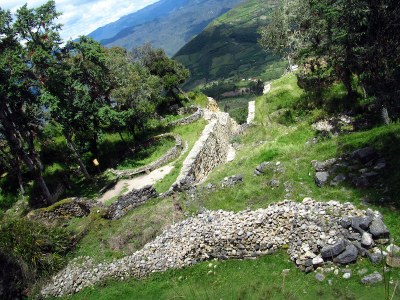
At the end of the day, I decided it would be best to ride with the van back to Chachapoyas to hit the ATM once more before we said goodbye to civilization. We rode back with the tour bus, but were not quick enough once we arrived, and missed the last official bus back to Tingo. As we already had a room paid for with all our gear inside, staying in Chachapoyas for the night wasn’t an option. Frustrated with ourselves, we paid 80soles ($30) for a private taxi back to Tingo. Carelessness had cost us, but after reminding ourselves of the lesson, we didn’t let it spoil the day. “Whats $30 to Tony Montana!!?”
Kings of the Future Highway
We left Tingo, and once more had a great day of riding ahead of us, with an almost imperceptible uphill gradient riding alongside a river amidst a beautiful valley. And while the afternoon’s gradient and road condition deteriorated, we arrived in Leymabamba in high spirits to find yet another Carnival festival. We checked into a great hotel with hot showers and a comfortable mattress.

While Bibi was cleaning up, I grabbed the camera and went back to see the action in the plaza. This time, the town was cutting down the tree in the central plaza. Music was playing, and the youngsters of the town were dancing frantically around the tree. An ax was being passed from person to person, and when the ax was received, that person would take a wack or two at the tree before passing it to the next person of their choosing.
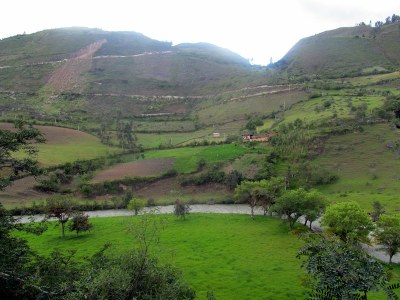
At first I stayed back with the video camera. Buckets of water and water balloons were flying everywhere, and I didn’t want to lose our last recording device. But the town would have none of it, and eventually the ax was in my hands, and I was dragged into the fray. I took a few chops, and then passed it along, rejoining the circle, hand in hand with the townspeople. Bibi has to see this, I thought, and I hustled back to retrieve her.
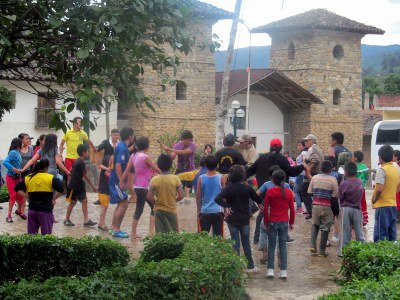
When we got back to the circle, the tree was still upright, but hanging by a thread. The ax was once more passed to me, and I dragged an uncomfortable Bibi into the center. We danced around the tree, taking occasional chops. I passed the ax, and the tree fell with the next person, and with it dozens of excited children rushed towards it to retrieve the presents tied securely in its branches. We backed off, snapping a few pictures as chaos ensued.
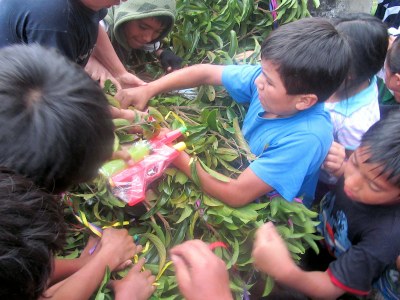
The university student who had been forceful dragging me into the midst approached us in a state of ecstasy. “People need this!” he stated loudly. “How do you feel? Incredible right? This is incredible.” I understood him. Even for the short while I had been in the middle of the group, I felt the common energy. I couldn’t disagree. Then I remembered that I’d ordered food nearly an hour ago, and completely lost track of the time. “We have to run. We’ll catch up later!” I’d hoped we would, as the muse was with us all at that moment, but it wasn’t to be. Bibi and I had dinner on our own, and then retreated back for a good night sleep.
In the morning, we hit the famous Leymabambe museum, which housed the mummies excavated from the Valley de Condors. Really incredible stuff. There was a room with perhaps 300 mummies. Chacha mummification is done with the corpse in the fetal position, and the slight variations in posture and positioning gave each its own unique expression. The faces of these mummified skeletons will stay with me a long time. Unfortunately pictures were prohibited, and camerawoman Bibi seems to give more credence to such rules than I.
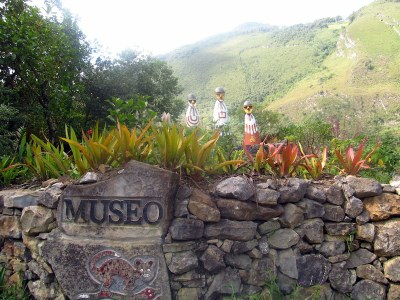
From Leymabamba, located around 2000m, we had a pass ahead of us that we’d heard reached above 4000m. This would be the highest point of my trip to date, and the climb would be made on an unpaved road. We climbed and climbed, and as it got later, colder, I began to think. Do we push on towards the pass and try to drop down the other side before making camp, or do we look for a place now before it gets too cold. Around 3200m we called it a day, finding a one horse town with a schoolyard where we could make camp.
We found a local who was willing to cook us dinner that night, and gratefully, we told her we’d be back around 6. We set up our tent, and as I did some bicycle maintenance, some boys came by, interested to figure out what we were all about. I showed both them and Bibi how to clean and lube the gears. The unpaved road was necessitating daily bike maintenance. This was not the time to be traveling with imperfect equipment.
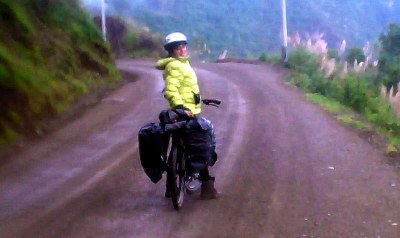
We talked with some locals, one who was particularly sharp and easy to understand. I forget all the themes we touched upon, but one question stuck with me. “Is it true that in the United States, people live in gold houses?” The fact that this question was asked by an otherwise intelligent person in earnest was alarming. “No I said. That’s the Incas.”
There was a tiny pup who was frolicking nearby, and when it was time for dinner, I grabbed him up and prepared to take him to our dinner hosts home as a meal. Cuy, or guinea pig was a popular dish in this area, and I wanted to see her reaction if a gringo walked in with a 6 week old puppy for the frying pan. I called the pup cuy, to everyone’s amusement except its owner, and seeing his concern, I immediately put the dog down. If the educated one thinks we live in gold houses, this kid certainly has no way of knowing if I’m serious about eating his puppy or not.
We arrived and sat around an open stove with the woman’s 10 year old son Nixon. I remember Bibi harassing him as he was helping his mom with the fire. “Are you a good son?” Nods yes. “A good brother? “ Nods yes. “A good student?” Nods yes. “A good friend?” Nods yes. “A good boyfriend?” Again Nixon nods yes, but then bright red, emphatically switches to no.
We ate dinner quietly. Despite understanding the woman and son well, we could not understand a word that the father said. We paid 5 soles for the meal and walked back to our schoolyard campsite in the dark and called it a night.

The next day we reached the pass (3700m) around 10am. We were wet, cold, and ready to drop down on the other side, but due to roadwork, all traffic was stopped until noon, when the workers would take their lunch break. Not even bicycles could pass. When Bibi heard the news, she immediately stated her intention of finding a car with heat to pass the next two hours in. This seemed an unlikely goal, given that there were only a handful of cars, and most had their motors off. But within a moment, a petite woman climbed out of what appeared to be a huge work truck and invited us inside.
This couple from Belgium offered us hot chocolate, coffee, and a full hot breakfast. They’d been traveling in this ridiculous pimped out truck (with a bed, full kitchen, solar generator, hot shower, etc) for more than 2 years across South America, and while the husband was frustrated throughout our short visit due to the delay, we had a wonderful chat with the wife about our journey and theirs.
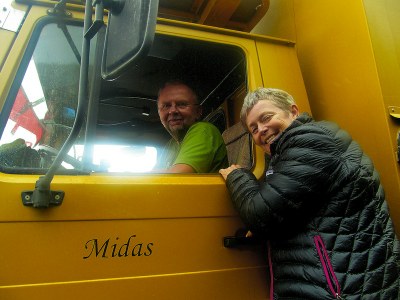
At noon, the hole was filled in, and we were all allowed to pass. But after we descended for an hour, we were stopped once more by roadwork. This time we insisted that we cross. We made friends, got our way, and then took a roadside picture together.
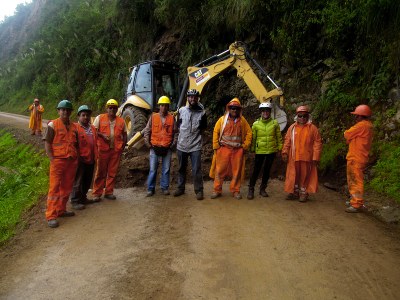
Then down we went to Balsas, the mango capital of Peru. After this incredible downhill stretch, we found ourselves on the outside of the town, with piles of rotting mangos lining the streets. I chatted with a young boy while waiting for Bibi to finish the decent and answered his questions about biking. He seemed fascinated by the machine. He hopped in the back of a truck, and I raced alongside, with this kid cheering the whole way. As we veered off in opposite directions, I tossed him my last bag of Sparkies, and Bibi and I headed into town to find a hotel.
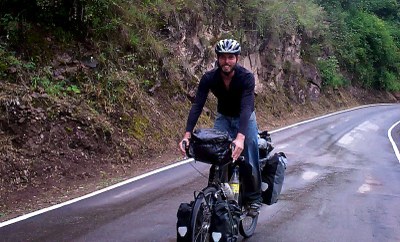
Just one more pass to go.
The Final Up and Over
We left Balsas at dawn, loaded with mangos and Sporades. We were below 1000m again, heading towards a pass that was rumored to be near 4000m. Brutal road conditions. Just 10 kms out of town we hit another road block that would hold us up until lunch, but this time the climate was more pleasant and we made the best of our time chatting with the rest of the traffic that was held up.
By the time we got free, it was the heat of the day, and before long Bibi was dehydrated. I let my frustration show more than I should, but eventually I conceded. We filled up our water jugs from an irrigation stream, purifying the jugs with chloro-fluorine drops. 30 minutes later, we stopped in for a late lunch and rested until the weather cooled off. I apologized to Bibi. We set off again, and she led the way. The reality at this point of our trip was that she was moving faster than me in the mornings and the evenings, but in the heat of the day, she would shut down. Her body just doesn’t support the heat.
That night we camped on the side of the road, as we stared up at the switchbacks. The valley we were overlooking was beautiful, and we felt all alone here. The village where we’d eaten lunch was now just a series of flickering lights below. An occasional bottle rocket would flash in the distance and then echo across the valley. Stars shone brightly for the first time in a number of nights. Everything felt dreamlike and unreal. I held her and laughed without reason for a long time, dancing on the empty unpaved road. It was a special night.
That night a fever set in and I slept poorly. We enjoyed a picturesque sunrise in the morning as we ate mangos for breakfast, but shortly thereafter it was obvious that I wasn’t right. It was all I could do to cover 2 kms without a break, and when I did earn a break, it was extended. Bibi was patient with me, and I felt like even more of an asshole for pushing her the previous day when she was dehydrated.
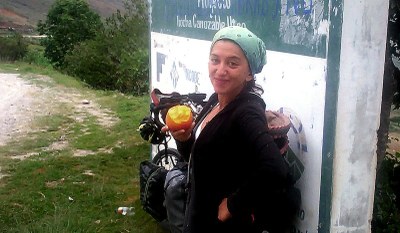
Surrounded by clouds, we had no sense of where we were going, or how far we were from the pass, but eventually we felt things start to level out. A small village appeared, and suddenly we were overlooking Celendin, 3700m above sea-level.
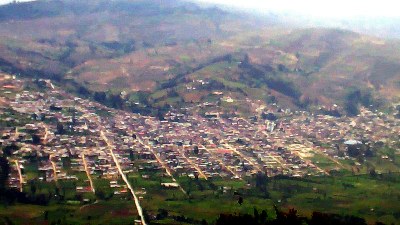
We dropped down into Celendin and had lunch, but it was clear I wasn’t going to be doing any more hard climbing that day. My condition made a hard decision a lot easier. We were running out of time to get back to Ecuador in time for work, in desperate need of a day of rest, and Celendin, wasn’t the place. We hopped on a bus to Baños de Inca after lunch and covered what would have been a full day’s bike ride in an hour and 10 minutes.
More Money than Time
Every trip has one of two limitations: money or time. For the first time in my travels in South America, I had to be somewhere, and we were short on the ladder. Johannes had decided to fly to Ecuador to prepare for the MLS Ecuador launch, and while I had resisted his flight date early on, having already outlined my trip plans to all parties concerned, I knew I needed to be back for his arrival. And despite how much we were enjoying the journey, I wanted to see my old friend and reengage myself with this project that was about to get underway.
We bused to Banos de Inca for a day of rest, arriving in the middle of a downpour. It was only the third time I’d used a vehicle while biking since Cartagena. (2 for work reasons and 1 to avoid the FARC) The first hotels we found were overpriced, and I found myself running around town looking for a hotel called Banos de Inca. One person told me this place existed and gave me loose directions, but everyone else I asked knew nothing of this hotel. I was looking for a place called the Inca Bath in the middle of a rainstorm. I began to wonder if this was a joke.
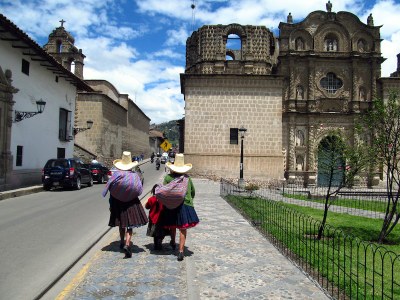
In the end we found an outstanding hotel (The Hotel Jacuzzi), which featured a large Jacuzzi tub in our bathroom, which was fed water directly from the hot springs. I went back to retrieve Bibi and we checked in. The lobby of this hotel was a mess, with rivers of water from the leaky roof passing through nearly all the public areas of the hotel. But the room was perfect, and we made ourselves comfortable.
I was still sick the following two days, but we traveled into Cajamarca to have a look around. I’d wanted to see the Ransom Room with there emperor Atahualpa was held hostage after being captured by Pizarro in one of the most brazen military assaults in the history of mankind. Atahualpa to fill the entire room with gold one time and silver 3 times, in exchange for his release. Pizarro accepted the offer, and the Incas brought in the precious medals. In the end, Pizarro killed him anyway. So went the great Incan empire.
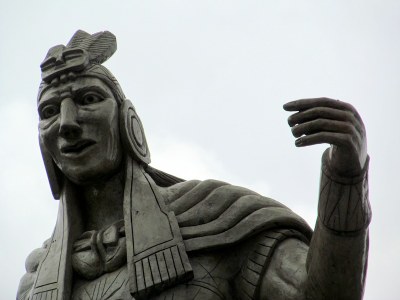
Unfortunately it was Monday—by this point of the trip we had absolutely no relationship with the days of the week—and the room was closed. Disappointed, we hit the mall for pizza instead and then went back to our hotel to relax more.
Early the next morning, my stomach was a mess, and I delayed our departure. Bibi pushed me hard. Our final destination was the famous Casa de Ciclistas in Trujillo, and both of us were ashamed at the mere thought of arriving by bus. I agreed, but I didn’t want to be sick on the side of the highway either. At 8 I took a test ride to see how I felt, and around 9:30 we had everything packed up and were on the road. According to Google we had two relatively easy days ahead of us, as we were descending from the 2600m to the coast.

As we passed through Cajamarca and asked for directions, Bibi met a woman who had opened a bicycle hostel in the area. They talked, exchanging information. She wanted us to take her business cards to Lucho in Trujillo, in hopes of receiving his referrals. We obliged, and then off we went. As it happened, we had a 400m climb after leaving Cajamarca to get over the last mountains. After all we had done, this shouldn’t have been difficult for us, (though I have said time and time again every 100m climb is difficult) but the unexpectedness of this final climb made it mentally challenging for us both. Finally we reached the pass and looked out from the Peruvian peaks for the final time. I took that moment to change out our brakes. It would be a steady decent the rest of the way.
Down we flew for the next 2 hours, winding our way through switchbacks and villages until we reached the river that we would follow all the way to the coast. That night we stopped in a town called Chilete. We fell asleep at the foot of the bed with the lights and door wide open within 2 minutes of our arrival.
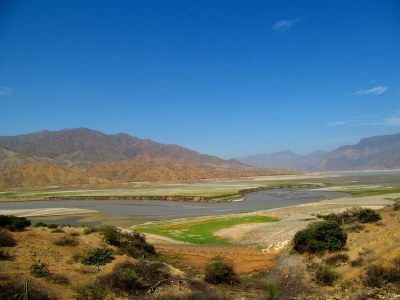
The next day would be final day on bikes. We learned that a road leading from Chilete to Trujillo which existed in both Google Maps and my GPS did not, never had, and never would exist. How Google can be wrong about an 80km paved road that doesn’t exist I have no idea. I’m sure Garmin probably just copied their mistake. At any rate, we had to go to Ciudad de Dios, a full 95 kms away, and then catch a bus south down the coast to Trujillo. At this point we didn’t care. We wanted to spend a day with Lucho and see the legend that is Casa de Ciclistas.
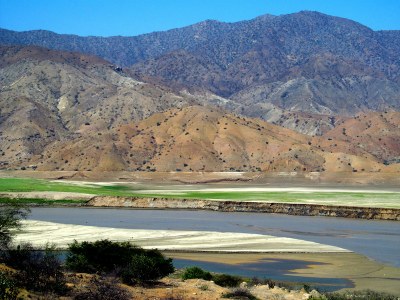
We followed the river all morning through a beautiful desert landscape. The heat could have made for a hard day for Bibi, but it was windy which kept our body temperatures down. We passed a beautiful reservoir where we took pictures and rested.
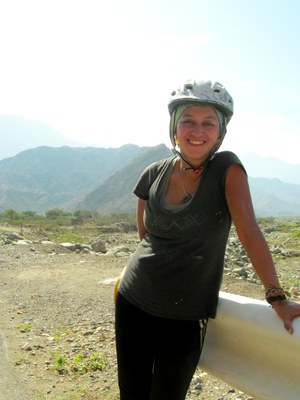
In the afternoon, I was riding out front when a motorcycle came around a turn to fast and wiped out right in front of me. It was ugly, but he was stable. We gave him water, phone calls, and helped him clean up his cuts. A karmic duty that I hope I never need paid back.
We arrived in Ciudad de Dios, which was hardly more than a bus stop. We bought a ticket for a bus that was leaving right away to Trujillo, but we were then informed that there was no space for our bikes, “and no we weren’t going to leave them for a separate bus to bring, thank you very much.” The next bus that could take us was 3 hours later, and we sat down at a restaurant and ordered a beer.
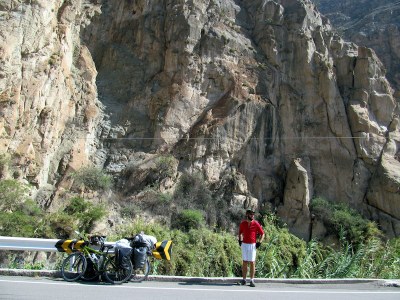
It had been a great day of riding, and a great trip that was coming to a close. Neither Bibi nor I knew what to say, both proud of what we’d done, sad that it was coming to a close, and anxious about the next chapter in our relationship, working jobs in a major city, finding and sharing an apartment together.
We arrived in Trujillo by bus around 8:30 that night and cabbed over to Casa de Ciclistas. Lucho met us on his bike, welcoming us to his workshop and leading us to our room in the back. We talked about the trip a bit, and I gushed about how far Bibi had progressed, going from the girl that really couldn’t ride the bicycle we purchased her in Quito 2 months prior, to a semi-professional who regularly clocks 90km days through unbelievable challenging terrains.
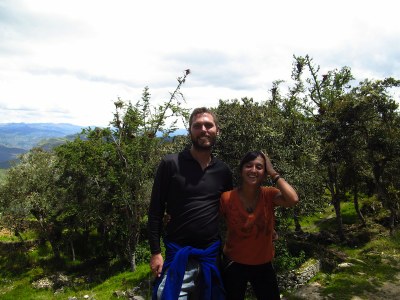
On the walls of Casa de Ciclistas, hang 2 large posters of bicycle tourists who were killed by vehicles that had passed through Lucho’s place. It was an emotional reminder of the dangers that are a part of traveling this way. We signed the Casa de Ciclista guestbook, numbering 1798 and 1799. 26 years of housing bike tourists. We were in the presence of greatness, and were humbled to join the ranks of this incredible lineage of adventurers.
Lucho then passed us another book, which was for messages, pictures, any kind of creative expression. Bibi and I spent hours reading its entries. There were hundreds of pages filled with bike photos, maps, and stories. And this was only volume 8. There were faces that I knew, familiar websites that I’d used for gathering information – ridingthespine.com, wegobybike.com. I found the Volger family who traveled South America with their two boys, who set the record for the youngest people to cover the entire PanAmerican on bikes. I found Tim Travis and his ex-wife Cindi, who remains one of my icons. We also found a German named Hans who holds the current record for longest bicycle tour. He left German on bicycle in 1962 and never came back.
The next day we printed some of our own trip pictures to add to the collection. Bibi had lunch with an old friend and I got a shave and a trip. The next day we would begin the 36 hour bus trip from Trujillo to Quito and then it would be back to work. I needed to clean up a bit.
That evening, I spent 3 hours talking with Lucho in his workshop as we trued the bike wheels, replaced the breaks and cleaned the gears. I could have spent weeks trading stories with this man and talking about bikes. We covered a huge range of themes, but hearing him talk of love was especially moving. When two people fall in love, he said, it is a highly volatile event, like two planets smashing into one another. Their lives change, and so do the lives of those around them. I thought of Chris, perhaps a casualty of the love Bibi and I fell into, and wished he could be there. I thought of the explosions that rocked the Coconut Hotel. I wandered what the future would hold for us and whether our two planets would stay fused together as we flew through this infinite universe.
Going Home?
In the morning Lucho rode with us by bike to the bus terminal, and after some arguing about whether our bikes would fit (in the end, there was always space) we boarded and begin the journey back to Quito, the origin of our trip.
Our first stop was Piura, where we were stopped in the central plaza by an old man. He asked us about our trip, and then proceeded to tell us his story. In 1954, this man had broken the record for longest time spent on a bicycle without stopping. 84 hours. We were amazed. “84 hours without sleeping and eating?? Where did you go?” we asked. “Just around town. I have the newspaper article about it if you want to come see it at my house.” We really wanted to, but our bus would be leaving shortly. Bibi assured that we would come back to Piura at the end of our time in Quito when we continued our journey. “If I’m still around, you will be welcomed,” he promised. We took pictures together and then headed back to the bus station. “How cool was that!!” we were both saying to each other.
Crossing the border on our way to Loja at 3am, our camera was stolen as we were waiting in line at immigration. It was dumb of me to leave anything behind in the bus, and while I wasn’t terribly upset about the camera itself, losing our photos from Lucho’s was the hardest part. But we were back in Ecuador with no problems at immigration.
We arrived in Quito the following evening, checked into a hotel, and began looking at apartments online. It was all over. 1400kms from the Amazon to the Pacific.
Who’s next??
